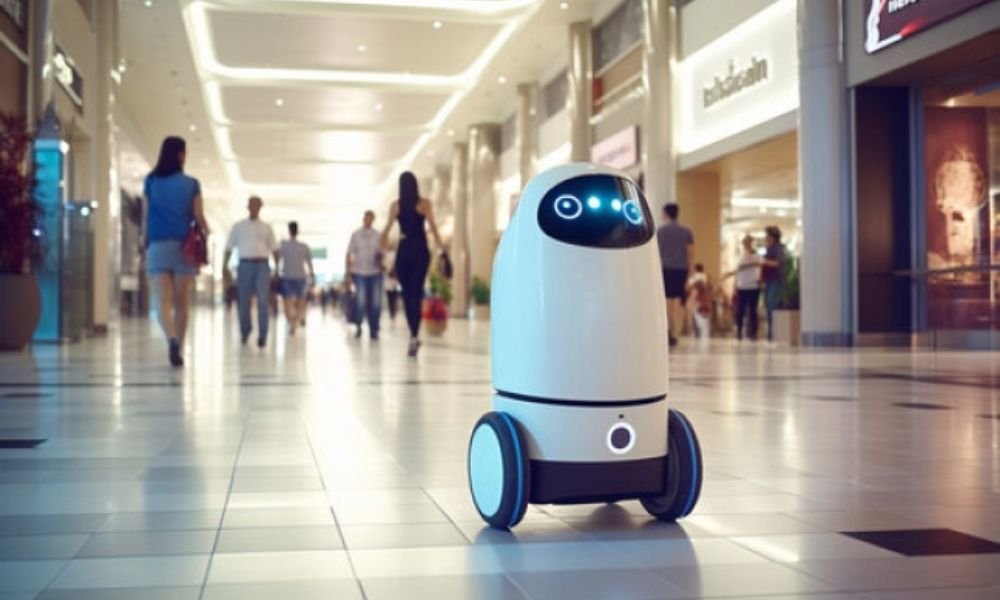Are robots becoming the new collaborators of our companies? This question, which might have seemed taken from a science fiction novel just a few years ago, is at the heart of many concerns today. Robotization , once confined to factories, is now entering all sectors of activity, profoundly transforming our working methods and our organizations. This article aims to decipher the issues of this revolution and to enlighten you on the opportunities it offers.
What is a service robot?
A service robot can be defined as an automated agent designed to perform useful tasks, either autonomously or in interaction with its environment.
Unlike industrial robots, which are generally confined to controlled environments, service robots operate in more open and varied spaces, such as offices, hospitals or homes.
They have sensors that allow them to perceive their environment and act accordingly, and can be equipped with tools or instruments to perform specific tasks.
Different Types of Service Robots

Service robots come in a multitude of shapes and sizes, each designed to meet specific needs. We can cite :
- Reception robots : Present in businesses, hotels or airports, these robots are capable of welcoming visitors, answering their questions and guiding them.
- Logistics robots : Used in warehouses and factories, they automate transport, storage and order preparation tasks, thus optimizing the supply chain.
- Assistance robots : These robots are designed to assist people in their daily lives, particularly the elderly or people with disabilities. They can help with mobility, completing household chores or taking medications.
Examples of applications in businesses
The applications of service robots in the business world are numerous and constantly evolving. For example, in the healthcare sector, robots are used to assist surgeons during delicate operations or to provide care to patients.
In the manufacturing industry, cobots ( collaborative robots ) work alongside humans to carry out complex tasks requiring high precision.
Finally, in the retail sector, robots can be used to carry out inventories, manage stocks or greet customers.
This article might interest you: What type of CRM does a company use?
The benefits of service robots for businesses

Gain in efficiency and productivity
Service robots are designed to optimize processes and increase business productivity. One of the main strengths of service robots is their ability to perform repetitive tasks with flawless precision and consistency.
By automating processes, robots make it possible to optimize the value chain and reduce production times . They can also be integrated into business management systems to improve planning and coordination of activities.
Improvement in the quality of services
Service robots help improve the quality of products and services by reducing human errors and ensuring high precision in task execution. For example, in the healthcare sector, surgical make it possible to perform operations with millimeter precision.
Less prone to human error than employees, service robots can also be used to personalize the customer experience by offering personalized recommendations, answering customer questions efficiently, or making home deliveries.
Impacts on human resources

The arrival of service robots is profoundly changing the organization of work. As repetitive and low-value-added tasks are gradually automated, employees are encouraged to acquire new skills. Mastery of digital tools, the ability to collaborate with machines and a deep understanding of production processes become essential assets.
Paradoxically, robotization leads to the creation of new professions. Companies need robotics specialists , systems integrators, programmers and data analysts to design, implement and maintain robotics infrastructures.
Faced with these developments, companies must invest in the training of their employees. This involves giving them the keys to understanding the challenges of robotization, supporting them in acquiring new skills and preparing them to work alongside robots.
Challenges and limitations

Robotization, although offering many opportunities, also raises a number of challenges.
The investment cost
The acquisition and implementation of service robots represents a significant investment for companies. The cost of purchasing machines, installing them, maintaining them and training staff represent significant expenses that can be difficult to justify for some organizations.
Safety and regulations
Security is a major issue in the deployment of service robots . It is essential to ensure that these machines are designed and used in a way that does not endanger people or property. Robotics regulations are constantly evolving, and businesses must adapt to new standards to ensure the safety of their employees and customers.
Employee acceptance
The arrival of robots in companies may generate resistance from employees, who may fear losing their jobs or seeing their tasks devalued. It is therefore important to establish transparent communication and encourage employee involvement in robotization projects.
Robotization it offers many promises, is not a miracle solution. Companies should carefully weigh the pros and cons before embarking on such projects. Good preparation, careful planning and effective communication are essential to make this transition a success.
Our opinion: A promising future, but to be qualified

The advent of service robots undeniably marks a turning point in the world of work. These intelligent machines offer immense potential to optimize processes, improve productivity and enrich the customer experience. However, it is essential to approach this technological revolution with a nuanced perspective.
Service robots are not a panacea. Although they are capable of performing many tasks with remarkable precision and efficiency, they cannot replace the emotional intelligence, creativity and adaptability of human beings. It is therefore crucial to design robotic solutions that complement employee skills rather than replace them.
Successful implementation of robotization requires a holistic approach. Companies not only need to invest in cutting-edge technologies, but also ensure their employees are prepared to work alongside robots. Training, communication and support are key elements to ensure a smooth transition.
Finally, it is important not to lose sight of the ethical issues linked to robotization. Robots must be designed and used responsibly, respecting human values and safety principles. It is essential to put in place clear regulations to govern the development and use of these technologies.
Conclusion
Rather than replacing humans, robots are encouraged to collaborate with them. This man-machine collaboration opens up new perspectives in terms of efficiency and creativity. Machines can take on the more arduous or dangerous tasks, while humans focus on activities that require emotional intelligence, creativity, and the ability to solve complex problems.




